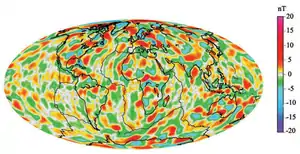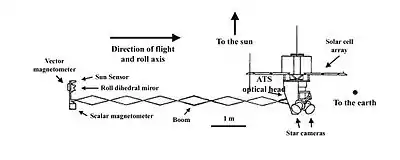Magsat
Magsat (Magnetic Field Satellite, Explorer 61, Applications Explorer Mission-3 or AEM-3) spacecraft was launched in the fall of 1979 and ended in the spring of 1980.[2] The mission was to map the Earth's magnetic field, the satellite had two magnetometers. The scalar (Cesium vapor) and vector (fluxgate) magnetometers gave Magsat a capability beyond that of any previous spacecraft. Extended by a telescoping boom, the magnetometers were distanced from the magnetic field created by the satellite and its electronics. The satellite carried two magnetometers, a three-axis fluxgate magnetometer for determining the strength and direction of magnetic fields, and an ion-vapor/vector magnetometer for determining the magnetic field caused by the vector magnetometer itself.[3] MAGSAT is considered to be one of the more important Science/Earth orbiting satellites launched; the data it accumulated is still being used, particularly in linking new satellite data to past observations.
 Magsat | |
| Mission type | Earth observation |
|---|---|
| Operator | NASA / USGS |
| COSPAR ID | 1979-094A |
| SATCAT no. | 11604 |
| Mission duration | 8 months |
| Spacecraft properties | |
| Launch mass | 158.0 kilograms (348.3 lb) |
| Start of mission | |
| Launch date | 30 October 1979, 14:16 UTC |
| Rocket | Scout G-1 S203C |
| Launch site | Vandenberg SLC-5 |
| End of mission | |
| Decay date | 11 June 1980 |
| Orbital parameters | |
| Reference system | Geocentric |
| Regime | Low Earth |
| Eccentricity | 0.0005741 |
| Perigee altitude | 351.9 kilometers (218.7 mi) |
| Apogee altitude | 578.4 kilometers (359.4 mi) |
| Inclination | 96.7488° |
| Period | 93.90 minutes |
| RAAN | 162.3717 degrees |
| Argument of perigee | 301.4198 degrees |
| Mean anomaly | 59.7851 degrees |
| Mean motion | 16.40347862 |
| Epoch | 30 October 1979, 09:16:00 UTC [1] |
| Revolution no. | 3497 |


After launch the payload was brought to an orbit of 96.8° facing the Sun as the Earth rotated underneath. It was kept in a close Earth orbit, with vector magnetometers capable of sensing magnetic fields closer to Earth's surface. The data collected by this satellite allowed a 3D-mapping of the Earth's magnetic interior as never seen before. In combination with a later satellite, Ørsted, it has been an essential component for explaining the current declining state of the Earth's magnetic field.[4][5]
History
On October 30, 1979 Magsat was launched from pad SLC-5 at Vandenberg AFB in California on a Scout II (101) rocket bearing 97° in a dusk to dawn orbit.[6][7] The spacecraft was placed in an orbit with a perigee of 350 kilometres (220 mi) and an apogee of 550 kilometres (340 mi). After reaching orbit, its telescoping boom was extended outward by 6 metres (20 ft). Two star cameras were used to define the position of the spacecraft relative to Earth. The orbit allowed the satellite to map a majority of the Earth's surfaces except the geographic poles. The satellite decayed from orbit on June 11, 1980.
Computers and data processing
According to a Johns Hopkins University / Applied Physics Laboratory (JHU/APL) report,[8] and archival NASA source documentation (Johns Hopkins APL Technical Digest, July–September 1980, Vol. 1, No. 3),[9] the MAGSAT spacecraft utilized two RCA 1802 microprocessors running at a 2 MHz clock speed in a redundant setup. A stored memory of 2.8 kilobytes in PROMs with 1 K bytes of random access memory (RAM) provided the program and working space for the microprocessor. Other integrated circuits chips of the CDP 1800 family of circuits were also used, including the CDP 1852 interface circuit and the CDP 1822 1K x 1 RAM, as well as Harris CMOS 6611A PROMS.
Three families of circuits were considered for the computer system design: two NMOS families (the Motorola 6800 and Intel 8080 microprocessors) and the RCA CDP1802 CMOS microprocessor. The 1802 was chosen based on various criteria, including the 1802 CMOS technology being power efficient by two orders of magnitude compared to the NMOS microprocessors, compatibility with the existing power supply of the satellite and the low-power requirements of CMOS, the radiation hardening of the 1802 and lack thereof in the 6800 and 8080, and other 1802-based functioning and features.
Software for the project was developed with an in-house APL-generated 1802 cross-assembler running on IBM 360/370 mainframe computers.
Critique
Magsat was not without problems. One of the biggest is that the motion of a metallic object tends to create a magnetic field. One study after the mission found a nonlinear fluxgate response when exposed to fields greater than 5000 mT. The applied field had to be transverse to the axis of the magnetometer.[10] The design was improved by creating a feedback relay over a spherical design.[11] This was the design used on later spacecraft [See:Ørsted (satellite)].
This configuration magnetometer was also later used on the Magnetometer of the Jupiter orbiter Juno, which arrived at the planet Jupiter in the 2010s.[12]
References
- "NASA - NSSDCA - Spacecraft - Trajectory Details". nssdc.gsfc.nasa.gov. Retrieved 2018-04-30.
- Langel R, Ousley G, Berbert J, Murphy J, and Settle M. The MAGSAT Mission. GEOPHYSICAL RESEARCH LETTERS, VOL. 9, NO. 4, PAGES 243–245, 1982
- "History of Vector Magnetometers in Space". Archived from the original on 2012-05-20. Retrieved 2008-07-08.
- Hulot G, Eymin C, Langlais B, Mandea M, Olsen N (April 2002). "Small-scale structure of the geodynamo inferred from Oersted and Magsat satellite data". Nature. 416 (6881): 620–3. Bibcode:2002Natur.416..620H. doi:10.1038/416620a. PMID 11948347.
- NASA AND USGS MAGNETIC DATABASE "ROCKS" THE WORLD NASA Web Feature, NASA
- Mobley F, Eckard L, Fountain G, and Ousley G. – MAGSAT — A new satellite to survey the earth's magnetic field. 1980. IEEE Transactions on Magnetics 16 (5): 758–760.
- Vandenberg AFB Launch History. The Space Archive
- Lew, Ark L. (February 1980). "Space Programs – The Microprocessor-Based MAGSAT Command System" (PDF). Retrieved May 16, 2016.
- "Johns Hopkins APL Technical Digest July–September 1980, Vol. 1, No. 3" (PDF). NASA Archives. Johns Hopkins. Retrieved 5 June 2016.
- Acuna, M. H., MAGSAT – Vector Magnetometer Absolute Sensor Alignment Determination. September 1981. NASA technical Memorandum 79648. Goddard Space Flight Center, NASA
- Primdahl, F., H. Luhr and E. K. Lauridsen, The Effect of Large Uncompensated Transverse Fields on the Fluxgate Magnetic Sensor Output, Danish Space Research Institute Report 1-92, 1992.
External links
 Media related to Magsat at Wikimedia Commons
Media related to Magsat at Wikimedia Commons
.png.webp)
